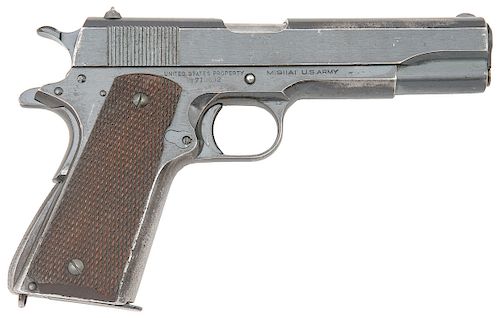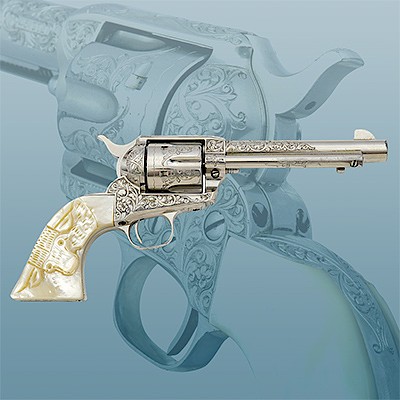Historically Important and Exceedingly Rare U.S. Model 1911A1 1938 Contract Pistol
About Seller
250 Commercial Street
Manchester, NH 03101
United States
Amoskeag Auction Company is a specialty firearms auction company based in New Hampshire. Our experience and location have allowed us to create a highly advantageous environment for marketing collectible firearms at auction. This environment coupled with our high level of integrity and rigorous work ...Read more
Two ways to bid:
- Leave a max absentee bid and the platform will bid on your behalf up to your maximum bid during the live auction.
- Bid live during the auction and your bids will be submitted real-time to the auctioneer.
Bid Increments
| Price | Bid Increment |
|---|---|
| $0 | $10 |
| $100 | $25 |
| $500 | $50 |
| $1,000 | $100 |
| $3,000 | $250 |
| $5,000 | $500 |
| $10,000 | $1,000 |
| $20,000 | $2,500 |
| $50,000 | $5,000 |
| $100,000 | $10,000 |
About Auction
Nov 17, 2018
Fine Antique and Collectable Sporting and Military Arms Featuring items from the collections of Cletus Klein, Tim Falvey, Dr. Jess Lewis, Dr. Louis C. March Jr., Roy Jinks & Others Amoskeag Auction Company amanda@amoskeagauction.com
- Lot Description
serial #713632, 45 ACP, 5'' Colt barrel with a bright excellent bore. In addition to being a very rare 1938 military contract Government Model pistol, this is the only known 1911A1 pistol issued by serial number to a United States submarine in private hands. The Story: The keel of the Squalus was laid on 18 October 1937 at the U. S. Navy Yard, Portsmouth, New Hampshire and was commissioned U.S.S. Squalus (SS-192) on 1 March 1939, with Lieutenant Oliver F. Naquin, USN, as her first Commanding officer. After having made eighteen previous successful dives, the sub made a trial drive at 0740 hrs on 23 May, 1939 while operating 13 miles southeast of Portsmouth, near the Isles of Shoals. Naquin, on the bridge, passed the word to ''stand by to dive'' shortly before 0900. Naquin descended to the control room beneath the conning tower as the Squalus dipped beneath the waves making 16 knots. The ''Christmas tree'' in the control room was all green, signaling that all hull openings, including main induction pipes behind the conning tower, were closed. These pipes ventilated the boat and fed air to the huge diesel engines, the dive required that the diesels shut down, and in rapid succession the inductions close, and battery-powered electric motors take over for underwater propulsion. As a backup safety test, a blast of high-pressure air into the submarine caused the on-board barometer to rise, assuring that inductions and all other openings to the ocean were shut. Naquin suddenly noticed a fluttering of air pressure fill his ears. Immediately the yeoman monitoring Squalus's intercom heard a frantic plea from the engine room. ''Take her up! The induction's open!'', the yeoman immediately reported: ''engine rooms are flooding, sir!''. Sea water poured into the boat through the induction pipes, one nearly three feet across. Naquin tried to surface by blowing ballast tanks. The boat hung static momentarily, struggling to shake free, but then the stern plunged backwards at a 45 degree angle. The captain, hanging onto the periscope, ordered his crew to close watertight doors between the ship's seven compartments. Standing watch between the control room and the rear compartments, Electrician's Mate Third Class Lloyd Maness tried to close the 200-pound door, the steep pitch of the sub requiring a superhuman effort. As the sea rapidly approached the bulkhead, Maness heard panicked voices, ''Keep it open! For God's sake keep it open!''. Five men struggled uphill, half swimming to safety, Maness then pulled the steel door shut, behind-which no one would survive. Seventeen men in the aft tried in vain to seal themselves in the torpedo room, nine others drowned in the engine and aft battery rooms just behind the control room. One man climbed a ladder to a hatch, which he undogged, but the pressure of sea water kept it from opening. The sea had rushed in to fill four of the submarine's seven compartments. Seawater began short-circuiting the boat's two batteries, arranged in 252 six-foot-high cells lining the keel. Chief Electrician's Mate Lawrence Gainer noted a rapid voltage drain in the forward battery room and knew immediately a hull-splitting explosion was imminent. The lights flickered and went dark, leaving the sub in blackness. With a flashlight, Gainer lowered himself below deck into the narrow crawl space between battery cells and disengaged one of two large disconnect switches, causing a lightning storm of blue-white sparks and melting insulation, blinded, he reached for the other switch and broke the circuit. He would be called by one shipmate ''the real hero who saved the ship, he went beyond the call of dutyÄ''. Luckily Squalus settled right side up on the soft ocean floor, 240 feet from the surface. Squalus was reported overdue and her sister ship USS Sculpin, headed for the Squalus's last known position. Squalus deployed rockets and a telephone buoy, both spotted by Sculpin, the buoy was fished aboard and the Sculpin's skipper, Lieutenant Commander Warren Wilkin, got on the phone. ''Hello Wilkie!'' said Naquin, ''Hello Oliver!'' replied Wilkin, at that very instant, a swell lifted Sculpin, and snapped the cable. The phone was dead. Almost immediately help was sent from New London Connecticut and the McCann rescue chamber would undergo its first true test, arriving on scene aboard the submarine tender USS Falcon along with Swede Momsen, its inventor. Mooring over the Squalus at 0800 hours, a hard-hat diver from the Falcon began his descent within an hour. The downhaul cable from a winch inside the rescue bell was connected to the Squalus's rescue hatch. Then two operators carefully maneuvered the bell, reaching the Squalus after an hour-long descent, at 1247 hours contact was established with the entrapped crew. Naquin divided the men into four groups for successive trips to the surface, the most severely debilitated evacuated first. In four trips, in total over a 40 hour period, all 33 men in the sub who lived were rescued. The fifth and last trip to the sub attached the ''diving bell'' to the aft rescue hatch, the compartment found to be flooded, leaving no doubt that the remaining 26 men had perished with their ship. Monumental efforts would then put forward to raise Squalus and after many setbacks, after laying on the ocean's floor for 113 days, Squalus was towed into Portsmouth. With war just declared in Europe, the Navy foresaw the need for every vessel afloat, so it was decided to recondition Squalus. The sub was decommissioned on 15 November 1939, after six months of extensive overhaul, she was recommissioned on 15 May 1940, USS Sailfish (SS 192), a name inspired by President Franklin D. Roosevelt after he saw the famous image of the boat breaching the surface during salvage operations. The Sailfish rejoined her sister ship, the Sculpin at Pearl Harbor in March 1941, the two logging many combat missions together during the war, together for the last time in November 1943 at Pearl. The USS Sailfish had an exemplary service record, logging 12 combat missions, earning nine battle stars and a presidential unit citation, sinking a total of 45,029 tons of Japanese shipping, including the 20,000 ton Japanese aircraft carrier Chuyo on 4 December 1943, the first Japanese aircraft carrier sunk by an American submarine. officially Sailfish accounted for seven enemy vessels sunk total, more if you read her logs. In one of the great ironies of the Second World War, her sister ship Sculpin was battle damaged and scuttled by her crew in November 1943, her commander, due to what he knew, choosing to go down with the sub rather than be captured by the Japanese. 43 of her crew were picked up by the Japanese and placed onto aircraft carriers heading for Japan. When Sailfish sunk Chuyo, 22 of sculpin's crew members were aboard, 21 did not survive. The one man who did, George Rocek of Cicero, Il, would later recall ''We cheered the (torpedo) blast even though we knew, if the carrier went down, we would probably never survive''. Another tale from November 1944 is somewhat more amusing, at 1544 hours on the 24th, a group of seven enemy patrol ships was encountered, Sailfish fired a four torpedo spread at one of the enemy destroyers she was closing, scoring two hits which blew the destroyer out of the water, she then went deep to avoid an aircraft attack. Much later upon surfacing, at 2340 an inspection of topside revealed one Japanese ''G-string'' (underwear) on her forecastle and one pair of Japanese pants caught on her forward gun. SS-192 Sailfish thereby claimed to be the first, submarine to not only catch a ''Jap'' with his pants down but also to actually take them off. The Gun: The 1938 government contract of Colt 1911A1 pistols are ranked among the rarest of the Colt Government Models. This example remains in extremely fine all-original condition. The metal surfaces retain about 92-95% original blue, showing wear to pewter on the frontstrap, leading edge of the triggerguard bow, sides of dust cover area of frame with some expected holster wear on right top of slide and left edge of slide. There is other light high edge and contact point wear with the mainspring housing a pewter patina. There are a few handling marks here and there, most notably along the frontstrap of the arm and a light reassembly scratch on the left side of the frame. The pistol wears correct fully checkered 28 row walnut grips and both slide and frame are numbered one to another. The barrel is a correct ''Colt 45 Auto'' marked Colt barrel with a ''P'' firing proof on the left lug and small ''G'' inspectors mark on its underside ahead of the lug. All of the markings are crisp and correct for a 1938 contract pistol including firing proofs and government inspectors stamps. A single blued Scoville magazine is included which rates excellent. Colt factory records confirm shipment in August 1938 in a 246 gun shipment to the Commanding officer Springfield Armory, Springfield Mass. United States Government Archive records confirm issue to the USS Sailfish by serial number, on July 24 of 1940, along with 9 other pistols, a Springfield Research Service letter confirming issue of serial number 713362 to U.S.S. Sailfish, is included. Included with the arm is the aforementioned Colt letter, Springfield Research Service letter and a copy of ''The Christmas Tree Was Green'', (Clean Sweep, the monthly publication of the San Francisco Chapter of The U.S. Submarine Veterans of World War II) a detailed narrative of the Squalus disaster and the hours which followed, as well as a bit of Sailfish's Second World War experiences. Actual naval-issued arms are a rarity among martial arms. To have a 1911A1 Government Model pistol actually issued to a United States submarine a singular rarity unto itself, to have that pistol be part of the 1938 U.S. Government contract is almost unthinkable; here is that gun. When you consider the boat upon-which this arm rode, through arguably the greatest conflict this nation ever faced, and that vessels astonishing history, this arm is a museum-worthy historic national artifact, well-worthy of the finest collection of Colt or martial arms. (38987-1) {C&R}
- Shipping Info
-
Amoskeag Auction Company, Inc. will make every effort to ship items in a timely fashion. All items, with the exception of modern handguns, are shipped via UPS Ground unless other arrangements have been made. • All modern handguns are shipped via UPS Next Day Air service. • Buyer is responsible for any and all shipping charges. • Orders are shipped in the order in which they are paid. PICKING UP MERCHANDISE • OUR OFFICE WILL BE CLOSED MONDAY AND TUESDAY FOLLOWING THE SALE. No merchandise will be delivered on those days. We will resume normal business hours on Wednesday. • Our office hours are Monday through Friday - 8:00 am to 4:00pm. Please call ahead prior to arriving to pickup your merchandise.
-
- Buyer's Premium



 EUR
EUR CAD
CAD AUD
AUD GBP
GBP MXN
MXN HKD
HKD CNY
CNY MYR
MYR SEK
SEK SGD
SGD CHF
CHF THB
THB













